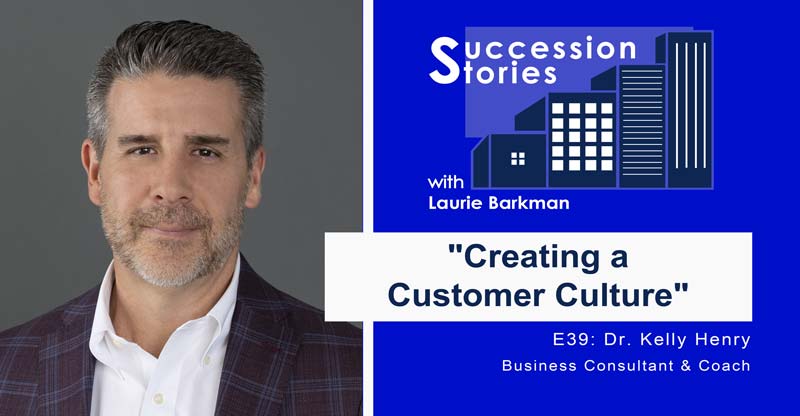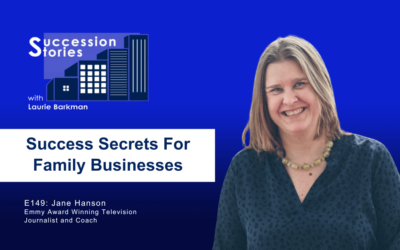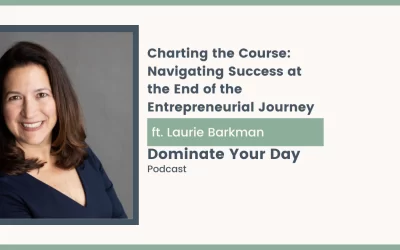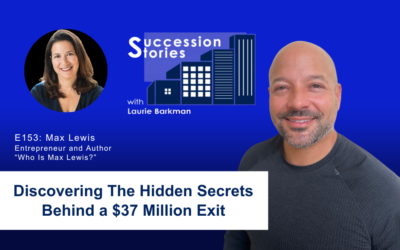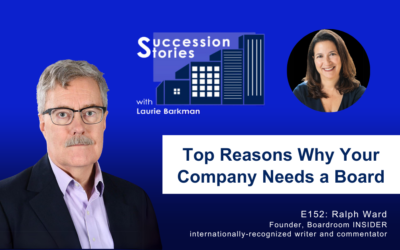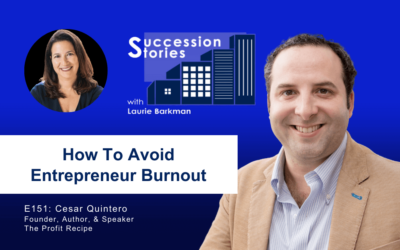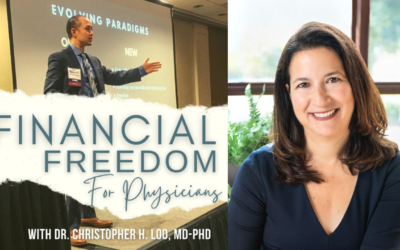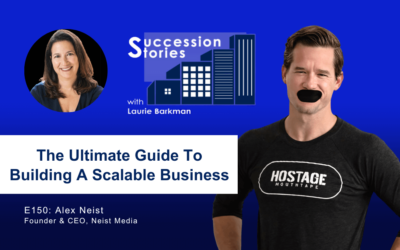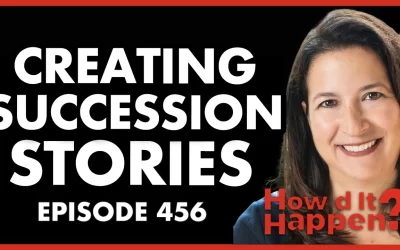In this episode of Succession Stories, Laurie Barkman is joined by Dr. Kelly Henry, a successful chiropractor and entrepreneur. Dr. Henry shares how a customer service culture led his practice to be among the top 10% chiropractic clinics in the US. He also talks about his experience selling the practice and how to harness the power of customer service to drive value in your business.
Listen in to learn more about:
- How to build value by developing a customer service culture
- Core drivers values of business value
- The role mentorship and advisory services play in achieving success
- Communicating beyond words through customer experience
- Customer value as a driver of profitable growth
Show Links
Dr. Kelly Henry’s website:
LinkedIn:
https://www.linkedin.com/in/drkellyhenry
Facebook:
https://www.facebook.com/drkellyhenry/
Connect with the host, Laurie Barkman on SmallDotBig.com and sign-up for an insights newsletter to build value in your company.
Follow Succession Stories
Be sure to follow wherever you listen on: Apple Podcasts, Google Podcasts, Spotify, Stitcher.
If you enjoy the episode, please give a 5-star rating and review to help others find the content. Here’s a quick how-to guide for Apple Podcasts/iTunes online.
Episode Transcript:
Welcome to Succession Stories, insights for next-generation entrepreneurs. I’m Laurie Barkman. I’ve spent my career bringing an entrepreneurial approach to mature companies struggling with change. As an outside executive of a third-generation 120-year-old company, I was part of a long-term succession plan. Now I work with entrepreneurs privately held companies and family businesses to develop innovations that create enterprise value in transition plans to achieve their long-term goals.
On this podcast, listen and while I talk with entrepreneurs who are driving innovation and culture change, I speak with owners who successfully transition their company and others who experienced disappointment along the way. Guests also include experts in multi-generational businesses and entrepreneurship.
If you are a next-generation entrepreneur, looking for inspiration to grow and thrive, or an owner who can’t figure out the best way to transition their closely held company, this podcast is for you.
Subscribe to our newsletter for more resources to build value in your business, visit smalldotbig.com and sign up today.
Laurie Barkman:
As Peter Drucker said, the purpose of business is to create and keep a customer. For that reason, I spotlight the topic of customer service as a way to drive value in your company. I had a great conversation with Dr. Kelly Henry. He shared his experience as a medical entrepreneur and how he grew and differentiated his practice with a customer service culture. Before selling in 2018, Kelly’s business was amongst the top 10% of chiropractic clinics in the US. We talked about getting acquired and transitioning to his next. Kelly now coaches business owners on how to ignite their enthusiasm for exceptional customer service to improve the bottom line of your business.
Laurie Barkman:
Dr. Kelly Henry, welcome to Succession Stories. It’s so great to be with you, and I wanted to tell the listeners first because this episode’s a little bit different. I don’t usually get to speak with someone who has built their medical practice and sold it and then is here to not only reflect on that, but to reflect on one of the core aspects that’s so important to creating enterprise value, which is customer service, and the value of what that brings to a company. So Dr. Kelly Henry, thanks so much for joining me today. It’s great to have you.
Dr. Kelly Henry:
Thank you, Laurie, I appreciate the opportunity. Great to be here.
Laurie Barkman:
Why don’t we start with you telling us a bit about your background? And what inspired you to go into the medical profession?
Dr. Kelly Henry:
Well, to be honest with you it’s completely selfish, why I moved into the medical profession i.e. chiropractic. We had a family friend when I was in high school, that’s a chiropractor, and got to know them pretty well through our church. And he was very successful. He had the boat, he had the lake house, he had snowmobiles, and so that really piqued my interest on “Hey, this guy’s doing alright. Maybe I should look into this and move in that direction.” So ultimately, that’s what started me on that focus and moving that way.
Laurie Barkman:
Did you come from a family of doctors or anything like that?
Dr. Kelly Henry:
I did not. My dad worked for the FAA his entire career, and my mom was a homemaker. She sold real estate and did taxes for people that ran their business that way. But no one in my family on either side had any kind of medical background as far as their occupation.
Laurie Barkman:
So you became a chiropractor eventually. And you where’d you grow up?
Dr. Kelly Henry:
I grew up in Colorado, just outside Denver.
Laurie Barkman:
Beautiful place. So you were a chiropractor. Tell me about that. Did you work with other doctors in their practice?
Dr. Kelly Henry:
I did initially. Got out of school, moved my family to Phoenix. So I graduated from chiropractic school in Dallas, where I live now. That’s why I fell in love with Dallas when I was here at school and always wanted to get back. And that’s where I moved back to a couple of years ago. But I graduated chiropractic school in the late 90s, moved to Phoenix, worked in a facility with other chiropractors.
I was gung-ho to open a practice or to build my practice to make my millions and to just change the world and pretty much what happened – that did not work out. It was an eye-opening experience; an utter failure in the sense of making money and building a successful business. But it laid the foundation because I was able to learn from the other doctors in this facility. So there were six doctors in a common facility. We each had our own practices and I was able to learn and understand the basics of business from working with these doctors and a couple of them had been in business for 20 plus years. So it was a tremendous learning experience for me there. It also gave me the ability, or once I became successful, I could look back at that, and appreciate being successful from when we were scraping by and having to rely on just hardly making any money and having to rely on handouts from family a few times. So that was a difficult time. But also, I could look back and say, “Hey, this is what ultimately was a stepping stone to my success later on.”
Laurie Barkman:
Yeah, it’s interesting for perspective, because as a medical professional, your experience is not only in serving patients but then you were also learning how to run a practice. And over time, I’m assuming you got exposed to the business side. I mean, it’s essentially a small business, right?
Dr. Kelly Henry:
It is.
Laurie Barkman:
But it’s got its nuances with certainly caring for patients, regulations, and insurance and all of that stuff. So when you talked about mentorship, which is fantastic, how did you learn the business side of a medical profession?
Dr. Kelly Henry:
Well, like you said, the mentorship laid a good foundation for me. I practiced in Phoenix for a year, bought a practice in New Mexico near where my wife’s from. So that helped tremendously because of what I learned at Phoenix and then I could apply that. I had instant patients, I bought a practice out from a retiring chiropractor that didn’t really have much left, but it gave me some instant patients to get some income. And so that was great. Initially, it was trial and error; “Let’s do this, does this work, let’s do this,” and it was pretty haphazard.
What really narrowed down my thinking was when I finally hired a business coach, about four years into that particular practice. And what happened was, I saw one of my buddies that I graduated chiropractic school with, he was doing quite well, “Hey, how did this happen? What have you done to be able to be that much more successful?” And he told me, “Hey, listen, I hired this company, these coaches, these consultants, you should do the same.” And I did. And that’s what really narrowed my focus in on the business aspects and putting in processes to build your business properly.
Laurie Barkman:
How many years had you been a doctor out of medical school before you bought the clinic in Phoenix?
Dr. Kelly Henry:
Well, the clinic in Phoenix I just went in, and we just started from scratch. So it was a year later that I was able to buy the practice in New Mexico. And then it was another three years before I finally hired a coach and consultant to help me with the business aspects.
Laurie Barkman:
So at that point, when you became the entrepreneur and the owner of that practice yourself, or maybe out of med school, what was it about five years or so?
Dr. Kelly Henry:
Well, just a little over a year, by the time –
Laurie Barkman:
Just over a year?
Dr. Kelly Henry:
Yeah, by the time I bought the practice in New Mexico.
Laurie Barkman:
Gotcha. So you were really on a steep learning curve. Curious about when you were deciding to buy that practice. What were some of the, if you reflect back — I realize this is a while ago now but — what were some of the things that helped you evaluate the value of that clinic? And how did you know what to pay for it?
Dr. Kelly Henry:
Yeah, that was another learning experience and a steep curve there too, just being naive and never have done it before. You take a lot of word off of the seller, and their honesty and they were selling me the “okay practice.” They wanted to sell me the building along with the practice. And of course, I didn’t have that kind of income, I had all kinds of student debt. So there were some challenges there. I somehow found, and I don’t recall how I found, that somebody had mentioned to me, but I believe it was called BEST. I don’t remember if that’s an acronym, but it was retired executives and business owners in the Phoenix area. And it was completely free. You could set up a consultation with them and they could help answer questions and business challenges.
I hooked in with them and got with a really knowledgeable executive. And basically, he told me, “Hey, listen, don’t buy the building. Here’s what the practice is probably worth. You’re buying blue sky, just patient files. You need to go look at the equipment and evaluate it, as far as age and those types of things.” And he really just gave me an outline of “Here’s what you need to do.” And I traveled to New Mexico from Phoenix, looked at it, had a better game plan, and we were able to negotiate the sale of the practice and it saved me tens of thousands of dollars getting that information. Otherwise, I would have been in a little bit of trouble if I would have bought it outright and just on faith from the sellers.
Laurie Barkman:
Yeah. That was great that you got that insight and advice that sounds like it was really helpful to you to understand the do’s and don’ts and that’s important. I think some people don’t always acknowledge they don’t know what they don’t know and they dive in and then the decision can either be great or they have regret. So it’s good that you didn’t have regrets. So you found yourself in New Mexico, you’re now going to build your practice. What was the area of focus once you took it over? You had some customer files, but where did you go from there?
Dr. Kelly Henry:
Well, maybe it was ‘just start making some money,’ because I had a young family at the time, we just needed to get some income going. So obviously, I wanted to take care of those patients and do what I did. I made one tremendous decision, that was very beneficial that I’m still working with today. And I made one very detrimental decision when I started that practice.
So the great decision was this particular community in New Mexico, a smaller community, a lot of the businesses were established for years, not a lot of competition. So their customer service was not great. And it didn’t take long for us to be involved with certain companies and just tell that they could care less that you were doing business with them. You had to do business with them and how they treated us bugged me. And so I just made a decision early on, within a few weeks of moving to this community that, “Hey, my clinic’s going to be different, we were going to treat my patients better, we were going to make them feel valued from day one. And so that that really laid a great foundation for me.
The big mistake I made was, I just did what this chiropractor was doing. I was just doing the same procedures, the same billing, the same attitude as far as finances, as in the patient paid whenever they wanted to, they came in whenever they wanted to, whether we got the billing out once a week, or once a month. I kept one of his employees and these type of things. And it wasn’t till I’d hired my business coach who was like, “You’re really not doing the right thing as far as the business aspect of things.” So there was the good, the bad there that kind of suffered through for several years before I finally got the coaching that I needed to help me refine and again, lay a foundation.
Laurie Barkman:
Can you give some examples? What were some of the red flags? Or did you find that patients would come once and not return? What were some of the examples that you can give some of the metrics that you were seeing?
Dr. Kelly Henry:
The chiropractor that I bought out, he was in his 60s. He’d been in practice for 35-40 years, long time, little different training that I had, and a lot of different communication. He was well established in the community, that type of thing. So that gave me an advantage because I still had a patient base. When I spoke with patients about health and doing certain things in a certain way, there was a lot of resistance there.
“This other doctor, he didn’t tell us to do that. You’d just come in when you’re in pain, or whatever the case may be.” So there was a lot of resistance to the change in that dialogue and presenting that information. The other aspect of that was, “Hey, you need to pay at time of service. Well, the other doctor, I didn’t have to pay, they just billed me and I paid whenever I wanted to.” That type of thing. And there was a lot of resistance with that, as well. And being young and naive and not having that information, it was just like, “Okay, well, I don’t want to upset anybody, let’s just keep those old standards in place.” And obviously, I suffered through for several years having that mindset and those business practices.
Laurie Barkman:
Yeah, that’s a tough spot. Because you knew from a cash flow standpoint, the upfront billing was going to be best for your business. For you, at the time, you probably didn’t want to risk losing those clients, those patients because you were trying to get the business off the ground. So I can understand that’s a catch-22. And it wasn’t until you probably got the customer acquisition wheel turning that you were bringing in enough new clients that if some of them, from the previous doctor, we’re ready to move on and they weren’t a fit for your new culture, that you had the confidence to say, “Hey, that’s okay, let’s part ways.” Is that what happened?
Dr. Kelly Henry:
You pretty much nailed it on the head there. That’s exactly what happened. A lot of it was through the customer culture that we established. We started helping the customer acquisition come into play and as my reputation grew in town, we were able to create that flow of new patients. And that was great, in which we were able to change the culture. Once I did that, two things happened. And I’ve talked to a lot of business owners about this, but when we changed that culture, I kept patients that wanted to be there, they understood the benefits of chiropractic and getting healthier. They paid on time and they took care of the business, so to speak. And I eliminated those patients that had that old mentality from the old doctor. And I lost probably a third, maybe a quarter of my business that way but ultimately that helped me skyrocket my growth getting rid of that bottom quarter that I was having to deal with. It’s kind of the 80/20 rule, “I’m spending more time on that 20% of people and just not making the impact I wanted to and the income out of them.” So it’s okay to let those kinds of customers go and focus your attention on the ones that are going to have the greatest impact and the greatest growth and the greatest profit.
Laurie Barkman:
How big did that practice get? How do you measure it? Is it numbers of patients? Is it in total billings?
Dr. Kelly Henry:
Both ways. We ran it up to $1 million a year, where I was treating between 300 to 400 plus patients. Well, 350 to 400 plus patients a week.
Laurie Barkman:
And so in a medical profession, how do you look at the lifetime value of a client? Was that something that mattered to the practice in terms of recurring revenue potential?
Dr. Kelly Henry:
Well, it was, in my estimation. And looking at that, my communication with my patients was to keep them coming back, not for my benefit, but for their health benefit. And so there’s a whole lot of dialogue that comes there, but I always looked at every time I had a new patient, my expectation was to keep them for the remainder of their life, not just because they had low back pain, and we cured that, but because we took care of it, and we wanted them to continue to stay healthy throughout it. So, again, the kind of simplistic view is, we wanted to keep those patients forever, and treat them in a specific way and communicate in a specific way. And we did a pretty good job of doing that. So to put a dollar amount on that, it’s kind of difficult because we kept patients for a long time, plus the insurances, the different fee schedules, the cash, it couldn’t be exact within those parameters.
Laurie Barkman:
Did you eventually take on other doctors as a group practice, or was a solo practitioner?
Dr. Kelly Henry:
I did. I hired associate doctors and ultimately started a satellite clinic in a nearby city, about 30 miles away that had doctors in it as well. So yes, I had five, six associate doctors that I trained and worked with me through the years.
Laurie Barkman:
Yeah, because it’s sort of a push and pull challenge for entrepreneurs. When they’re growing their business, they’re very, very close to their customers. They understand their needs, they know them by name. As a doctor, you were seeing many of your patients directly, correct? You knew everybody who was coming in?
Dr. Kelly Henry:
I did so. And that was difficult. That first hire, first associates, and to let them take care of some of the patients was very difficult from my standpoint because I had control there. And from the patient’s standpoint, because they were so used to me. And all it boils down to is communication. It wasn’t because I did such a great job, that’s what we had to let the patients know; not because I was the greatest chiropractor in the world but “We want to get the effects for you, and help you get out of pain and become healthier. So whether it’s myself doing it or the associate doing it, it doesn’t matter, we’re going to get the same effect. You’re gonna get the same treatment, you’re going to be valued here in our clinic.” So once the patients started realizing that you can see that it was a pretty smooth transition from there on out.
Laurie Barkman:
How did you bring the marketing speak or the sales speak to “Hey, you’re going to have a great experience with us, you’re going to feel better,” whatever the benefits are, why they would want to come to your practice, to putting that into place? How did you bring that to life in the business culture and with the patient care?
Dr. Kelly Henry:
Well, like I said, I started very early on when I moved to New Mexico, just making that decision. And I just backed into it. I wasn’t doing it from a sales opportunity, or really to grow my practice. I just hated being treated like I was an inconvenience for other businesses. So I’m like, “Okay, let’s, let’s change that.” What was interesting was once we started doing that and I communicated to the one employee I had, and we did a better job of it, patients started communicating back to us, “Hey, we just love coming in here, the way that you treat us and how you respect us and value us.” And so that obviously we wanted to continue to perpetuate that and so we did, and that’s the thing. You can’t verbalize it “Hey, we’re here to serve you. We’re going to give you the best experience,” because so many businesses do that yet their actions speak louder than words. I wanted the other way. We didn’t have to verbalize that a lot. The patients just felt that and when they felt that and they experienced it and it was an attitude and a culture, we didn’t have to explain it, we didn’t have to speak it to them. And when they felt that, they left there and they were telling their family or their acquaintances or the people they worked with, “Hey, you need to go see this chiropractor. Because they are great. And they treat you well and you get phenomenal service there.”
Laurie Barkman:
Yeah, that makes a lot of sense. And I just wanted to mention a quote from one of the listeners, it’s somebody I used to work with, and from time to time people submit quotes to me, and I say I’ll include them in the show.
And this is from Kevin MacPherson, a former colleague of mine. And this is originally from Theodore Roosevelt. And he says, “People don’t care how much you know until they know how much you care.”
And I thought that really matched what you were just saying there, Kelly. That when people were coming into your practice, it was probably how they were greeted, and you were on time.
It drives my husband absolutely insane when he goes to a doctor’s office, and they make him wait. And he’s thinking, “Is their time more valuable than mine?” It sends the wrong message. Obviously, no one’s trying to be late. Maybe there are inefficiencies, or there’s something going wrong in the backside. But I think for all those aspects, and for listeners who are thinking, “Oh, well, I don’t have a medical practice, I can’t relate.” Well, we probably can relate that everyone’s got experiences where they walk in somewhere, and maybe there’s a grumpy greeting or no greeting. There’s no eye contact. And I’m guessing in your practice, that was not the case.
Dr. Kelly Henry:
You’re correct. And what I coach businesses on is having a bookend for the experience, meaning when a client, customer, or patient walks into a business, to have that eye contact, to have that welcome, “Hey, great to see you. We’re glad you’re here.” That type of situation. I call that being overly friendly, and immediate acknowledgment of that customer, that consumer. But equally as important is having a great farewell and acknowledgment when that customer is leaving the business at the end of the transaction. Because ultimately, that’s more likely what they’re going to remember. And a lot of businesses fall flat on the other side of things. So yeah, they do a great job of acknowledgment on the front side, but then they kind of fall flat on the back end of things. And again, that’s the impression that the consumer will take away often more than the friendly beginning.
Laurie Barkman:
Well, let’s finish this growth story before how you grew your practices. And I think I saw a statistic somewhere that you were in the top 10% of chiropractic practices in the country, is that accurate?
Dr. Kelly Henry:
It is. By volume, patient, load and by collections.
Laurie Barkman:
Which is incredible. And that was a 20 year story that played out over some years. It wasn’t overnight. But ultimately, you sold your practice. Is that correct?
Dr. Kelly Henry:
That is correct; in 2018.
Laurie Barkman:
So I wanted to chat a bit about that. What was the process like to sell your clinics? Because at this point, how many clinics did you have?
Dr. Kelly Henry:
I had two clinics.
Laurie Barkman:
Okay, so how long did the process take what was involved? And we’ll just talk a bit about it.
Dr. Kelly Henry:
One question the listeners may have is why if I was successful in practice, why would I sell so I want to address that real quick. I mentioned earlier that I bought a chiropractor out near where my wife grew up in sort of that practice. Again, an older gentleman in his 60s, great chiropractor, but he basically got past his prime, so he really didn’t have anything left for me to buy from him. Several years later, I bought another chiropractor out in that same community and the same situation; in the 60s didn’t have much left. It was good for me, not good for them, I benefited from it. So I made a mental note that if I was going to retire from chiropractic, and I didn’t know at that point if I was, but if I was going to, I was going to sell at the top when I was at my prime and had something of value to give and sell to somebody else. And in 2017, I just felt like I was led to, “Hey, it’s time to sell. It’s time to change focus and move on.” And so I actually got with a medical practice broker and they did a phenomenal job of evaluating and putting a price tag basically on my practice. It was all kinds of information. It was documentation, it was tax returns, it was I mean to the nth degree, so they knew exactly what I had and what I was offering. And then from that point on, they did the advertising then put the word out through the chiropractic journals in the colleges and the different areas and different avenues that they could do that. Ultimately that’s what attracted my buyer to me. And then it took a little bit of negotiation and making sure he was able to get the financing and do the things that he needed to do. So it was roughly about a year’s process from when I decided to go through the broker and then ultimately signed the papers in 2018 to sell the practice.
Laurie Barkman:
Okay. Yeah, and I think it’s interesting too to look at it from the eyes of the buyer. Somebody has this very smart quote that says businesses aren’t sold they’re bought. And from that aspect was it eye opening for you to understand what a buyer is valuing, and how they’re valuing it in your practice?
Dr. Kelly Henry:
To some degree. Although it was such a good experience because we were trying to make it a win-win. And so we had a back and forth. But it was very win-win for both parties. I knew in my mind what I had, but also kept in mind, that whole year as I was trying to sell, basically, I wanted to have a good product. And so I just kept stepping back, and looking, “Okay, where can I make this better? How can I make this better? What can I do here? Where am I falling short?” and just improved even that last year, because I wanted whoever stepped, in whoever bought that practice, to have the top-notch practice they could have. When we finally signed the papers, I told him, “Hey, listen, I’m basically giving you the keys to a Ferrari here. I’ve got systems in place, all you need to do is just step in, and follow what I’ve done, and you’re going to have tremendous success.” And he’s done that to the tee and actually even built the business up over what I originally had.
Laurie Barkman:
That’s fantastic. I mean, that’s what I work with clients on. There’s essentially eight core drivers of value, and you hit on a number of them in what you’ve talked about today, one of which is having the business to be able to thrive without you, and how you did that. And your story was by putting processes in place, creating a culture to be fostered and cared for, even if you’re not in the room. And certainly the behind the scenes, the back office processes being efficient, effective, that all part of that.
Another big part of it is the revenue side. Because essentially, when a business is getting acquired, a big part of that is your profitability, and certainly the history on that and your and your EBITDA. And for medical practices too, not that I’m an expert, but I was reading a bit about it just to see and there is a commonality in how businesses are valued, one of which is certainly the predictability of future revenue potential. And so if you had grown your client base consistently over three-plus years, and you had shown profitability increases, and you have good customer metrics, which I’d love to talk about here in a second, that all goes into the predictability of the future revenue potential, and therefore reducing that risk, which is therefore increasing the value to a buyer. So that’s very exciting. Did you get the magic number that you had in mind that you probably sealed in an envelope and said, “If I get this number, I will take it”? Did you get that number?
Dr. Kelly Henry:
Well, I actually did the sum on the practice a little differently than we did. Basically, a buyout is what it amounts to. But when they originally evaluated it was $1 million, and I forget the exact numbers. So that would have been nice to have that cash. The buyout afforded the buyer to not have to put down a ton of cash. As a new practitioner, a massive amount of student debt, there’s no way he’s going to be able to get a significant loan to buy the practice. So it’s kind of the best of both worlds. Where it saved him cash, he doesn’t make the income initially coming in making more, and then it’s grading scale through the years. So, to me, that was a win-win, because it benefited us. I’m still part owner in it, as he’s buying me out. And so I still do some management, I still train the staff, I still work with him to make sure we’re still on top of things and keeping things running as smoothly as possible.
Laurie Barkman:
Okay, yeah. And some people might position that as an earnout like we call it.
Dr. Kelly Henry:
Exactly.
Laurie Barkman:
So that’s great, and that’s a win-win. And that’s what matters.
Dr. Kelly Henry:
Absolutely.
Laurie Barkman:
So that’s great, and that’s a win-win. And that’s what matters. And so in that process of transitioning your role from day to day and primary owner to partial owner and more of an almost like a coach and mentor to the new owner certainly with an equity stake and an interest in their performance, what does that mean to you in that transition? How did you think about that? Did you feel like you were really ready for what that meant, or was there kind of a feeling of loss along the way?
Dr. Kelly Henry:
There was definitely a feeling of loss. Fortunately, the broker that we worked with had done hundreds of these, so they gave us an outline, “Okay, here’s what you need to do.” We let the patients know what was going on early on, a month or two before the practitioner who bought me out came into the practice so I can answer questions and kind of soften the blow and we did a 90-day transition from myself adjusting to him adjusting as we work together and that day that we actually transitioned and said, “Okay, I’m done being the chiropractor here, I’ll still be active.” And at that time, we still lived in New Mexico near the practice. That day was pretty difficult. I thoroughly love taking care of patients. I love the communication with them. I love the interaction with them. I love to joke around with them. And so backing up from them that was difficult.
Laurie Barkman:
I understand, and that’s just hard. So we find ourselves a couple of years later now. And you’re in a different headspace because certainly, time makes it easier. But also, because you’ve moved into your next, which I think is an exciting thing to talk about. So let’s jump into your next career, which is as a customer service consultant, and coach, how did you determine that path?
Dr. Kelly Henry:
That’s a great question. Going back to when we moved to New Mexico making that decision my clinics would be customer-centered, and excellent customer service, again, that started this journey of learning and implementing and putting it into place. And I saw the impact of it in my practice. I’ve seen it countless times, and we all do, bad customer service all over the place. So I knew “Hey, this helped me so much I know I can help others with this.” And then going back to being coached, I’ve been coached since 2003. I’ve had multiple business coaches, I’ve had personal coaches, speaking coaches, all kinds of coaches, I’m still being coached. And I knew the impact that had on my business and my life. So when I made this pivot, it was pretty easy to mesh the two; ‘I want to be a coach, and I want to coach on customer service,’ because I knew the impact of both those areas.
Laurie Barkman:
That’s something really important. You saw the value, and wanting to bring that value to other people. There were a couple of great articles, many, many out there, but certainly the big why. And I was sort of thinking about the big why in this conversation. And Harvard Business Review has some wonderful articles out there. One statistic I saw is that companies that freely foster loyalty, grow revenues about two and a half times as fast as their industry competitors. And so certainly customer value can be a source of profitable growth.
One of the things that I look to measure with clients is if they have any metrics around customer satisfaction, or customer loyalty, or likelihood to recommend, one of the key metrics that I like to use is the net promoter score. And so no matter how an organization measures, I guess my point is, it’s important to measure. I worked in a very, very big company, we had a process where we were measuring quarterly, across the whole company. So it was a very big effort. Now, I’m not saying quarterly is necessary, but certainly, something quantifiable, especially if you’re building your company to sell. Which for you in your practice, ultimately, that’s what you did. And there was data around as we just talked about a moment earlier about your customers and how they stayed with you and all those metrics. How do you start with a client to really understand and quantify where they are today and help identify the gaps of where they could be in terms of their customer satisfaction metrics?
Dr. Kelly Henry:
Yeah, we do extensive audits and, I don’t know if they call it finding the holes but, that’s what we ultimately end up doing. Finding the holes in their customer service culture is what it amounts to. Almost every business will wave their hand and say, “Oh, yeah, we provide great customer service.” Almost every business has pieces of great customer service and what they do there but it’s not necessarily a culture, they have pieces and actions that they do that they say “Okay, this qualifies as saying we provide great customer service.” And when you don’t think you have a problem, there’s no need to look for a cure. And so that’s why we’ll go through the thought and start finding, “Okay, here’s where you’re missing the boat.” When you’re missing the boat and customer service, you are not creating loyalty, you’re losing customers and obviously, you’re gonna lose profitability. And so we’re very careful and very detailed in working through an audit to find those deficiencies.
Laurie Barkman:
Yeah, because it costs a company about five to 10 times or greater to acquire a new customer than it is to retain a customer.
Dr. Kelly Henry:
Actually, five to 25 is the statistic guys use, but yes, exactly. And they just don’t see that. So many businesses are sales-oriented, sales-minded. And my goal is to shift them into “Let’s be more service-minded.” Because if you’re service-minded, you will serve more, I mean, you will sell more. Yes, you need those sales, you need to acquire new customers. But the greatest growth comes from keeping those customers. Retain those customers and that’s where the growth and the profitability will exponentially come from. There’s a statistic from Harvard Business School, and they did a study where if a company will just increase retention by 5%, it can lead to a 25 to 95% increase in profits. And so that’s, that’s the name of my program, The 5% Bump. We try to push that retention rate up by 5% by changing the culture as far as customer service and creating more loyalty.
Laurie Barkman:
Do you work with clients in any particular industry? Are these medical professionals or are they really across any industry?
Dr. Kelly Henry:
It’s across the board, any service-based industry. I have a passion for the medical side of things, just because I speak their language, obviously. Chiropractors, physical therapists, they have a very similar business model in a lot of aspects so I’ve had success working with him as well. But what I like about the medical side of, or helping the medical profession is, and this is what I saw in my own practice, is, when you’re taking care of a patient, from a health standpoint, when you’re providing great customer service, it actually can help the outcomes. From a chiropractic sense, if we’re making the patient feel valued, and relaxing them, and helping them feel more important that’s actually changing their physiology, which makes it easier for me as a chiropractor to take care of them. And ultimately, it helped with our outcomes. Because we weren’t treating them in a way that they didn’t like, was tensing them up, or they hated coming to my office. They were relaxed, they loved being there. And there, the body was able to heal itself a little bit quicker. So that leads into physical therapy and the other medical professions as well, if they are on top of their customer service game.
Laurie Barkman:
Do you think that there’s going to be changes in how companies need to think about customer loyalty and customer service, given the pandemic and how, ultimately, whether it’s face-to-face interactions or online interactions?
Dr. Kelly Henry:
I do. I think improving customer service is more important now than ever. And unfortunately, small businesses are dying off at a rapid rate right now. And I hate that. And those that are able to sustain and function through this, as consumers, we’re a little tighter with our money right now. Anytime that happens, people will not put up with mediocre or worse customer service. And so if you really want to make your business shine, and continue to not only survive, but thrive, you really need to make the shift and get on board with this customer service improvement.
Laurie Barkman:
Yeah, and I know a lot of companies are struggling with what is their next and they’ve been changing their business model, they’ve been changing a lot of things. But one thing’s for sure people do want to continue to know that they are important to the companies they do business with. So regardless of that, I think our earlier quote from Teddy Roosevelt still very much holds. There’s another quote that I wanted to share, which is from Peter Drucker. And he says, “The purpose of business is to create and keep a customer,” which I think very much falls in line with everything that we’ve talked about today.
Dr. Kelly Henry:
I love that quote.
Laurie Barkman:
Yeah, it’s a great quote. When you work with your clients today, any major mistakes, if you want to call it that, stand out to you as examples of what not to do?
Dr. Kelly Henry:
Yeah, probably the biggest one, the most prominent one, the most prevalent one is you have to treat your employees well, in turn for them to treat the customers well. So a happy employee will be more inclined to make a happy customer. And that’s what we see a lot of. Not that businesses are ruling with an iron fist and cracking the whip, but they’re just not valuing their employees like they should. And that I didn’t do that for several years in my practices. I looked at my employees as liabilities, and they were there just to collect a paycheck doing the bare minimum and my job was to correct every little mistake they made. And one of my business coaches called me and said, “Listen, you need to look at your employees as assets, and start calling them on all the good they’re doing cause they’re doing way more good.” And when I made that shift, voila! Guess what happened. It increased our reputation for great service. Same thing with so many businesses, they just — again, it’s not that they’re terrible with their employees — but they can be a whole lot better. Look at them as assets, value them first, and then, in turn, let them, let the employee value the customer. So that’s a huge mistake a lot of businesses are making.
Laurie Barkman:
Agreed. Where I’ve seen success is using employee surveys, certainly, but having focus groups, having your finger on the pulse with your own teammates, to their attitudes and how they feel. And the question, I think, that the net promoter score really gets to is the likelihood to recommend this service or business to a friend or colleague. And if you think about it in the same vein as being an employee, would you recommend this employer? Would you want to work here enough to recommend a friend or colleague to work there? And it’s really the same question, if you think about it, the zero to 10 rating, and be able to quantify that and find who the promoters are, who the detractors are, and then again, that net number, that’s really the key. Whether it’s employees or customers.
So I definitely work with my clients on that to try to quantify, and however, we choose to do it, whether it’s a simple one question or if it’s something more complex like the Gallup polls utilize, there are some great tools out there to measure over time because you want to establish this baseline length. Like you’re saying, you come into a new relationship with a client, you’re going to do some triage, you’re going to understand where are they now as if they’re walking into your clinic. You’ve got to understand where they are now and where are those gaps? Where are the pain points? And then where can they go from there and establishing that roadmap? So that makes a lot of sense. Anything that I didn’t ask you about Kelly, that you want to share in terms of what you believe success factors to be and having a customer-oriented culture?
Dr. Kelly Henry:
I like what you mentioned there. I’m very simplistic in my approach, really all along in my practices, and certainly what I’m doing now, with my customers. I don’t want to make this hard for them so I’m very simplistic in applying the customer service principles, those types of things. As far as the metrics to be measured, the three — and I got this from Jack Welch, the CEO of GE, for many years — if you want the metrics that you need to follow, they are; survey the customer, survey the employees, and then watch cash flow. And just follow those through. So that’s always good.
Another mistake that I see that and I alluded to it, mentioned just a few moments ago, is to take those blinders off, take the blind spots off for many businesses, but the statistics are 80% of the businesses in the United States function at a level of average, to just downright poor customer service. So the vast majority, but yet these same businesses are the ones waving their hands that “Oh, yeah, we provide great customer service.” So I would just encourage business owners in the listeners to step back and look over, “How often do we train? Is this really really ingrained in our culture? Is this really a focus for us?” And step back and evaluate themselves and see if this is really something that they’re doing. They champion that they are. But let’s step back and look at it. And if you’re not, then maybe it’s time to take steps to make a shift. There’s no downside to improving customer service. There’s no downside because your customers, your consumers, your patients, clients, they’re never gonna stop wanting to be valued and feel important and feel special by doing business with you. And when you do that, all it leads is to creating relationships, creating bonds, creating loyalty, and creating greater business. So keep those things in mind.
Laurie Barkman:
That’s a great first step for companies that are thinking about this and wondering how they are doing? And I know you value tools and toolsets, you mentioned that earlier, and you’ve written a book about it, and to help small business owners understand what they could be doing better. Do you want to tell us a little bit about the book?
Dr. Kelly Henry:
Absolutely. The book’s entitled, Define and Deliver Exceptional Customer Service, and going back to my simplistic mindset, that’s what the book is about. It’s just proven strategies to maximize profits. And it gives the rules the principles of great customer service, some very simple action steps that a business can put into play that can have actually incredible benefits if they’ll just put them in play. The key is consistency. You have to be consistent with developing this culture. And this is another hang-up that a lot of businesses have and I address this in the book is, improved customer service, they’ll champion that as a flavor of the month, as a shiny new object. But they just don’t have the necessary mentality. They just don’t look at it as a long-term goal, that it needs to be a foundation put into place and everything moving forward is built upon that. So we have to be clear with that. Consistency is key when we’re dealing with customer service.
Laurie Barkman:
Yep, absolutely. I’m sure you have many, but one of the things I like to ask my guests is if they have a favorite quote about entrepreneurship or leadership, and I’m wondering if you have one.
Dr. Kelly Henry:
Absolutely. One of my favorite quotes, and I use it all the time, think about all the time, is from Zig Ziglar. And he says, and I’m sure most of you heard this, “You can have everything in your life you want, if you will help enough others get what they want.”
“You can have everything in your life you want, if you will help enough others get what they want.”
And to me that really encompasses the customer service culture, and from my standpoint of what I do, and what I did in my practice is to serve first. Serve others first and they can help you get what you want. But you have to have that mentality of serving others first.
Laurie Barkman:
I love that. That’s a great quote. So last question. Before we wrap here, how do others find you online?
Dr. Kelly Henry:
For example, drkellyhenry.com is my website. And then you can find me on LinkedIn under Dr. Kelly Henry and Facebook, Dr. Kelly Henry. So those are my three main platforms. Love to talk to you about changing your customer service culture in your business. So you can email, text, however you want to get a hold of me, I’d be more than happy to talk with you about helping your business.
Laurie Barkman:
Kelly, thank you so much for coming on Succession Stories. I think it’s an important aspect for people as they think about their transitions in their business, especially if they’re looking to grow and sell one day to build value around customers. So thanks so much for sharing your insights.
Dr. Kelly Henry:
Thank you, Laurie. I appreciate the time.
Laurie Barkman:
Innovation, transition growth. Easy to say but hard to do.
If you’re an entrepreneur facing these challenges. I get it. I work with businesses from small to big for strategic planning with your team to achieve your vision.
Visit smalldotbig.com to schedule a call with me. I’d love to connect with you. Be sure to catch the next Succession Stories episode with more insights for next generation entrepreneurs.
Subscribe to Succession Stories and if you enjoy the show, please share a rating and review.
Thanks for listening!

